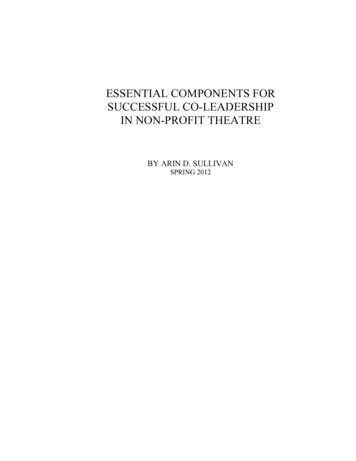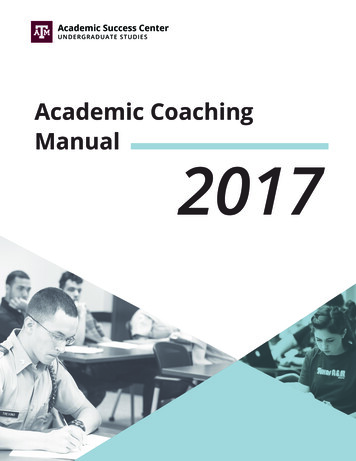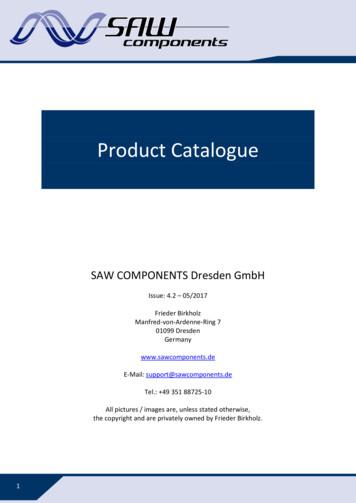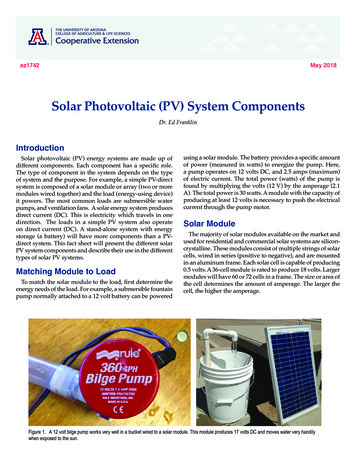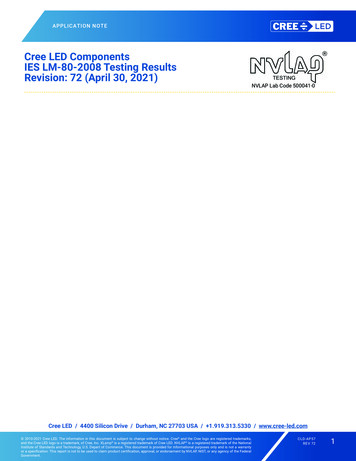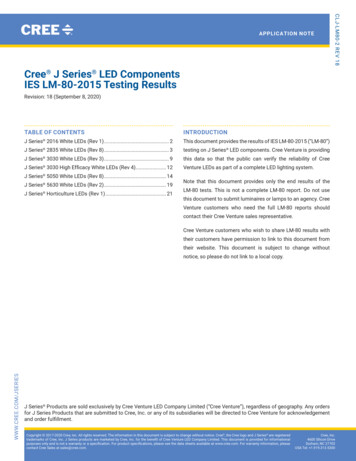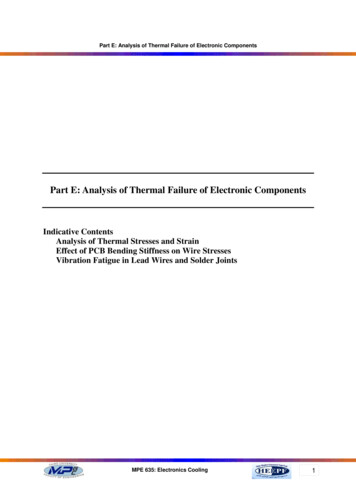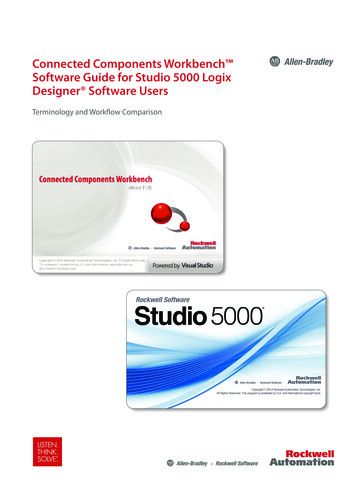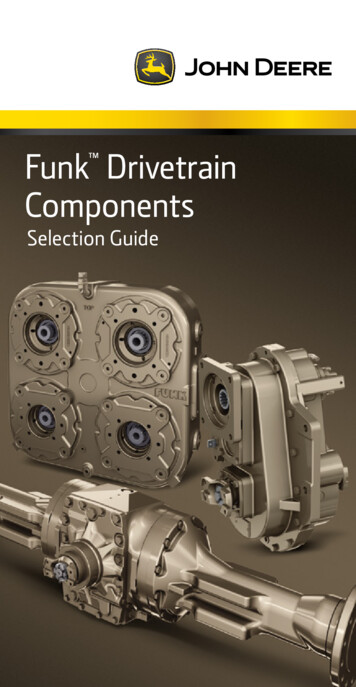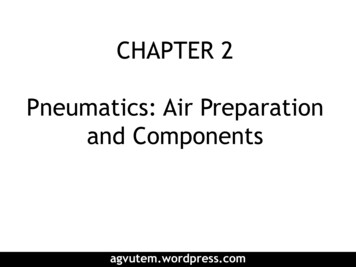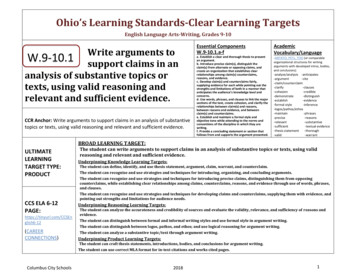
Transcription
Ohio’s Learning Standards-Clear Learning TargetsEnglish Language Arts-Writing, Grades 9-10Write arguments tosupport claims in ananalysis of substantive topics ortexts, using valid reasoning andrelevant and sufficient evidence.W.9-10.1CCR Anchor: Write arguments to support claims in an analysis of substantivetopics or texts, using valid reasoning and relevant and sufficient evidence.Essential ComponentsW.9-10.1.a-fa. Establish a clear and thorough thesis to presentan argument.b. Introduce precise claim(s), distinguish theclaim(s) from alternate or opposing claims, andcreate an organization that establishes clearrelationships among claim(s) counterclaims,reasons, and evidence.c. Develop claim(s) and counterclaims fairly,supplying evidence for each while pointing out thestrengths and limitations of both in a manner thatanticipates the audience’s knowledge level andconcerns.d. Use words, phrases, and clauses to link the majorsections of the text, create cohesion, and clarify therelationships between claim(s) and reasons,between reasons and evidence, and betweenclaim(s) and counterclaims.e. Establish and maintain a formal style andobjective tone while attending to the norms andconventions of the discipline in which they arewriting.f. Provide a concluding statement or section thatfollows from and supports the argument presented.AcademicVocabulary/Language-ABTATO, PETs, TOO (or comparableorganizational structures for writingarguments with developed intros, bodies,and conclusions)-analyze/analysis ish-establish-evidence-formal textual evidence-thesis statement-thorough-valid-warrantBROAD LEARNING TARGET:The student can write arguments to support claims in an analysis of substantive topics or texts, using validreasoning and relevant and sufficient evidence.ULTIMATELEARNINGTARGET TYPE:PRODUCTUnderpinning Knowledge Learning Targets:CCS ELA 6-12PAGE:Underpinning Reasoning Learning ONNECTIONS)The student can define, identify, and use thesis statement, argument, claim, warrant, and counterclaim.The student can recognize and use strategies and techniques for introducing, organizing, and concluding arguments.The student can recognize and use strategies and techniques for introducing precise claims, distinguishing them from opposingcounterclaims, while establishing clear relationships among claims, counterclaims, reasons, and evidence through use of words, phrases,and clauses.The student can recognize and use strategies and techniques for developing claims and counterclaims, supplying them with evidence, andpointing out strengths and limitations for audience needs.The student can analyze the accurateness and credibility of sources and evaluate the validity, relevance, and sufficiency of reasons andevidence.The student can distinguish between formal and informal writing styles and use formal style in argument writing.The student can distinguish between logos, pathos, and ethos; and use logical reasoning for argument writing.The student can analyze a substantive topic/text through argument writing.Underpinning Product Learning Targets:The student can craft thesis statements, introductions, bodies, and conclusions for argument writing.The student can use correct MLA format for in-text citations and works cited pages.Columbus City Schools20181
Question IdeasArgumentation/Analysis: After researching (informational texts) on (content), write a/an (essay or substitute) that argues your position on (content). Support your position with evidence from yourresearch.[Insert question] After reading (literature or informational texts) write a/an (essay or substitute) that addresses the question and support your position with evidence from the text.Argumentation/Comparison: After researching (informational texts) on (content), write a/an (essay or substitute) that compares (content) and argues (content). Support your position withevidence from the texts.[Insert question] After reading (literature or informational texts) write a/an (essay or substitute) that compares (content) and argues (content). Support your position with evidence from the texts.Argumentation/Evaluation: After researching (informational texts) on (content), write a/an (essay or substitute) that discusses (content) and evaluates (content). Support your position withevidence from your research.[Insert question] After reading (literature or informational texts), write a/an (essay or substitute) that discusses (content) and evaluates (content). Be sure to support yourposition with evidence from the texts.Argumentation/Problem-Solution: After researching (informational texts) on (content), write a/an (essay or substitute) that identifies a problem (content) and argues for asolution. Support your position with evidence from your research.[Insert question] After reading (literature or informational texts) on (content), write a/an (essay or substitute) that identifies a problem (content) and argues for a solution(content). Support your position with evidence from the text(s).Argumentation/Cause-Effect: After researching (informational texts) on (content), write a/an (essay or substitute) that argues the causes of (content) and explains theeffects (content). What (conclusions or implications) can you draw? Support your discussion with evidence from the texts.[Insert question] After reading (literature or informational texts) on (content), write a/an (essay or substitute) that argues the causes of (content) and explains the effects(content). What (conclusions or implications) can you draw? Support your discussion with evidence from the texts.Ohio’s Learning Standards Appendices SupportAppendix C Samples of Student Writing: Examples of Grades 9-10 argument writings with annotations can be found on pages57-59 and 65-67.Ohio Department of Education Model Curriculum Instructional Strategies and ResourcesToulmin Model--A Strategy for Structuring Arguments The Toulmin Model provides students a structure for organizing their academic arguments. At the most basic level, students start with an overallthesis to lead into their evidence (Data), and then provide their explanation of the evidence (Warrant). The “lew” portions can be repeated depending on the amount of evidence to be included in the argument.More advanced students can also add Backing, Qualifiers, and Rebuttal to further develop their arguments. A Toulmin Debate can be connected to future career aspirations by choosing a topic pertaining to thecareer fields. For instance, a debate can occur between students on selecting the best equipment or tools for purchase, choosing organic versus non-organic farming, or using ornamental design versus solid crafting.Color-Code the Documents Each element of an essay is color-coded (e.g., introduction red, thesis green, etc.) to help identify focus and structure. This website allows the teacher to set up color codes withthe essay element, and students can highlight the element, as they understand it. This also can be done on electronic files by either using different color fonts or the highlighting tool. This could especially be used formatching entries on the works cited page with their corresponding citing in the text. Survey Monkey or other online sites can be used to help conduct field research or run simple polls.Writers’ Workshop Writer’s workshops generally feature two aspects: an instructional experience and an opportunity for practice for a specific writing skill. These workshops can be structured many differentways. Some educators prefer to deliver via direct instruction to an entire class; whereas, others may prefer a station rotation setting where students participate in an inquiry-based learning experience. Edutopia’s“Creating A Writers’ Workshop in a Secondary Classroom” features different options for teachers to customize their workshops. Using stations to implement writers’ workshop begins with the development ofstations where students will concentrate on specific writing skills based on formative assessments. Students use peer or teacher reviews to revise or develop writing content and construction.Thesis Generator Ashford University’s thesis statement development tool helps students develop a guiding statement for their writing. Several variations of a thesis statement are provided, and students mustdecide which is best for their audience and purpose.Standardized Test Sample Question StemsWrite a multi-paragraph response in which you make and support a claim about whether cultural artifacts should be returned to their regions of origin. Your response must be based on ideas andinformation that can be found in the passages. Manage your time carefully so that you can: review the sources; plan your response; write a thorough response; and revise and edit your response. Besure to: include a claim; acknowledge and distinguish claim from alternate or opposing claims; use evidence from multiple sources; and avoid overly relying on one source.W.8.1 (Prior Grade Standard)W.11-12.1 (Future Grade Standard)Write arguments to support claims with clear reasons and relevantevidence. a. Establish a clear thesis statement to present an argument. b. Introduceclaim(s), acknowledge and distinguish the claim(s) from alternate or opposing claims, andorganize the reasons and evidence logically. c. Support claim(s) with logical reasoning andrelevant evidence, using accurate, credible sources and demonstrating an understanding of thetopic or text. d. Use words, phrases, and clauses to create cohesion and clarify the relationshipsamong claim(s), counterclaims, reasons, and evidence. e. Establish and maintain a formal style.f. Provide a concluding statement or section that follows from and supports the argumentpresented.Write arguments to support claims in an analysis of substantive topicsor texts, using valid reasoning and relevant and sufficient evidence. a.Columbus City SchoolsEstablish a clear and thorough thesis to present a complex argument. b. Introduce precise, knowledgeable claim(s),establish the significance of the claim(s), distinguish the claim(s) from alternate or opposing claims, and create anorganization that logically sequences claim(s), counterclaims, reasons, and evidence. c. Develop claim(s) andcounterclaims fairly and thoroughly, supplying the most relevant evidence for each while pointing out the strengths andlimitations of both in a manner that anticipates the audience’s knowledge level, concerns, values, and possible biases.d. Use words, phrases, and clauses as well as varied syntax to link the major sections of the text, create cohesion, andclarify the relationships between claim(s) and reasons, between reasons and evidence, and between claim(s) andcounter claims. e. Establish and maintain a formal style and objective tone while attending to the norms andconventions of the discipline in which they are writing.f. Provide a concluding statement or section that follows from and supports the argument presented.20182
Ohio’s Learning Standards-Clear Learning TargetsEnglish Language Arts-Writing, Grades 9-10Essential Components W.9-10.2.a-gWrite informative/W.9-10.2 explanatory texts toexamine and conveycomplex ideas, concepts, andinformation clearly and accuratelythrough the effective selection,organization, and analysis of content.CCR Anchor: Write informative/explanatory texts to examine andconvey complex ideas and information clearly and accurately throughthe effective selection, organization, and analysis of content.ULTIMATE LEARNINGTARGET TYPE:PRODUCTa. Establish a clear and thorough thesis to presentinformation.b. Introduce a topic; organize complex ideas, concepts, andinformation to make important connections anddistinctions; include formatting (e.g., headings), graphics(e.g., figures, tables), and multimedia to aidcomprehension, if needed.c. Develop the topic with well-chosen, relevant, andsufficient facts, extended definitions, concrete details,quotations, or other information and examples appropriateto the audience’s knowledge of the topic.d. Use appropriate and varied transitions to link the majorsections of the text, create cohesion, and clarify therelationship among complex ideas and concepts.e. Use precise language and domain-specific vocabulary tomanage the complexity of the topic.f. Establish and maintain a formal style and objective tonewhile attending to the norms and conventions of thediscipline in which they are writing.g. Provide a concluding statement or section that followsfrom and supports the information or explanationpresented (e.g., articulating implications or the significanceof the topic).Essential Understanding-MLA Formatting for in-text citations and works citedpagesAcademicVocabulary/Language-ABTATO, PETs, TOO (or comparableorganizational structures for writinginformative/explanatory text withdeveloped intros, bodies, and conclusions)-analyze/analysis -articulate-cite-clarify-cohesion-complex in-specific/tier three vocab-establish-examine-formal/informal styles-informative/explanatory text-maintain -norms -multimedia-organizational strategies (definition,classification, comparison/contrast, cause/effect)-objective sis-transitionsBROAD LEARNING TARGET:The student can write informative/explanatory texts to examine and convey complex ideas, concepts, andinformation clearly and accurately through the
Thesis Generator Ashford University’s thesis statement development tool helps students develop a guiding statement for their writing. Several variations of a thesis statement are provided, and students must decide which is best for their audience and purpose. Standardized Test Sample Question Stems Write a multi-paragraph response in which you make and support a claim about whether cultural .
